Partner content: Operators help save many lives but they need to upgrade their disaster management as the frequency and severity of natural and human-made disasters escalates
Telecom operators are the backbone of our society. They connect the world, and we can’t live without the mobile and fixed connectivity we have today. Additionally, and often without anyone noticing, they play a crucial role in our security and health, with emergency communications literally saving lives.
However, we also live in an era where the frequency and severity of natural and human-made disasters are escalating. To give an order of magnitude for this problem, we present the following data:
- “The number of disasters has increased by a factor of five over the 50-year period: whereas 711 disasters were recorded for 1970-1979, 3536 were recorded in 2000-2009” (ourworldindata.org).
- “The data shows that countries with limited to moderate multi-hazard early warning systems coverage have nearly six times higher disaster-related mortality ratios compared to those in countries with substantial to comprehensive coverage” (undrr.org).
- “More than half the global population – around 4.5 billion people – are at high risk of experiencing an extreme weather event, such as a flood, drought, cyclone, or heatwave” (worldbank.org).
The approach to disaster management needs a significant upgrade, and that’s why the introduction of Virtual Command Centers as a Service (VCCaaS) is set to revolutionise how telecom operators and public safety stakeholders manage and coordinate disaster responses. By using state-of-the-art technology such as AI and digital twins, VCCaaS will enhance operational efficiency, improve situational awareness for civilians and emergency workers, and ultimately save lives.
This idea was proposed by a group of operators and vendors who collaborated to transform it into reality. This ongoing journey has passed through various catalyst phases, and this year, in phase V, a demo was created and recognised at DTW24 with the prize of “Outstanding Catalyst, Tech for Good”. The project brought together Celfocus, Antel, Chunghwa Telecom, Cognizant Technology Solutions, Esri, Futurewei Technologies, Infosim, Intersec, MTN, NTT Group, Orange, Telecom Italia, UBique and Verizon Communications.
How is VCCaaS being implemented?
This solution must give networks “superpowers” of agility and resilience, delivering emergency services with a real-time 360° view of field operations. VCCaaS addresses this need by offering situational awareness and crisis management from a central, mutualised location with real-time predictability and mass alerting capabilities.
VCCaaS leverages several advanced technologies to enhance disaster management capabilities:
- AI for Risk Prediction: Proactively forecasts potential disaster impacts, enabling preventive measures.
- Digital Twins: Provides a comprehensive 360° view of situations, facilitating real-time assessment and decision-making. This virtual representation of the physical environment aids in effective monitoring and planning.
- GIS & Location Intelligence: Enhances situational awareness by enabling live positioning of assets, ensuring optimal resource deployment.
These technologies collectively streamline disaster management, reduce response times, and improve coordination, leading to more efficient disaster recovery. For instance, the network can predict where a fire will propagate, advise populations, rearrange connectivity to guarantee communication for firefighters, and provide them with data-driven decisions.
While AI and state-of-the-art technology are crucial for this success, the key to this achievement has been the collaboration and the architecture defined between different operators and partners – each one was focused on their challenge but 100% aligned with the global vision, always sharing different perspectives that enriched the solution.

Use Cases and Advantages
For this catalyst, we focused on two use cases, demonstrating its versatility and effectiveness:
- Operational Efficiency: Enhances emergency service operations by providing a predictive centralised platform for coordination and communication, ensuring all teams are synchronised for a quick and effective response while maintaining the network’s functionality.
- Early Warning Systems: Provides timely public alerts, crucial for minimising disaster impact. By issuing early warnings, VCCaaS helps mitigate the effects of disasters and saves lives.
Implementing VCCaaS can reduce disaster-induced damage by up to 30% when early warnings are issued within 24 hours. Globally, this could result in avoiding losses of $3-16 billion annually, highlighting VCCaaS’s significant impact on disaster management and recovery efforts.
Collaborative Efforts for Success
Achieving the full potential of VCCaaS requires robust collaboration between the public and private sectors. Collective efforts towards standardisation, security, and skill development are essential for driving this transformation. The catalyst project exemplifies this collaborative spirit, bringing together a multinational team to effectively develop and deploy VCCaaS.
This collaboration extends beyond development. Continuous cooperation is necessary to ensure the system remains effective and up-to-date with the latest technological advancements. By working together, stakeholders can create a more resilient and responsive disaster management system that benefits everyone.
The Path Forward
Transitioning to VCCaaS marks a significant shift in disaster management, offering numerous benefits, including enhanced operational efficiency, improved coordination, and reduced disaster impact. By embracing these technologies, telecom operators and public safety stakeholders can better prepare for and respond to disasters, ultimately safeguarding lives and property.
As VCCaaS enters its fifth phase, its mission to develop a disaster-handling virtual command center continues to grow. The integration of AI with autonomous networks and digital twins into a single interface offers a comprehensive real-time view of operations, assets, and infrastructure. This development ensures that critical infrastructure and resources, such as power grids, transportation networks, and healthcare facilities, are monitored and managed efficiently from a central location.
Real-time situational awareness and mass alerting capabilities integrated into the VCC will play a crucial role in ensuring timely responses and minimising the impact of emergencies on communities. The VCC will enable emergency management teams to access critical data at any time, regardless of their location, providing a 360-degree view of unfolding situations and remaining assets. This real-time data will inform the allocation of emergency services in the field, improving the overall effectiveness of disaster response efforts.
The effectiveness of the VCC will be measured by key performance indicators related to the operational efficiency of emergency services, such as activation time, response time, communication effectiveness, resource allocation, predictive analysis, and consistency of response. As VCCs become established and AI systems support predictive analysis, emergency services won’t need to start from scratch for each incident, leading to standardisation of emergency response procedures, efficient execution, and lives saved.
We, Celfocus, as a key contributor, will continue this journey to help the VCCaaS project succeed. We will use our Analytics and Cognitive knowledge and experience to make a difference in the future of disaster management. We have a drive for all of this: to create a safer, more resilient world, where communities are better prepared to face the challenges of tomorrow.
For more information on VCCaaS and its implementation, visit TM Forum Catalyst Projects here.
About the author
André Vieira is the Operational Intelligence Offer Lead at Celfocus. He started his career providing consulting and engineering services in telecommunications, developing and leading several projects focused on Telcos across Europe, Africa, and Asia. In 2021, he joined Celfocus to manage the Celfocus Order Management Product. He refined product offerings and managed customer relationships and partnerships. He is now leading the offer of a Business Unit – Operational Intelligence – that combines technologies and professional services that speed up the delivery of the foundations of digital transformation while leveraging the Telecom Operator ecosystem. Since February 2023, he has also been the leader of the communication and adoption working group for Project Sylva, a Linux Foundation Europe project.
Contact: andre.antunes.vieira@celfocus.com




